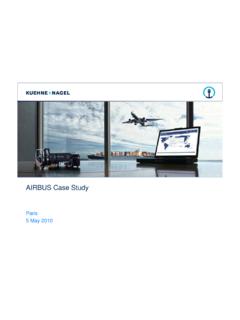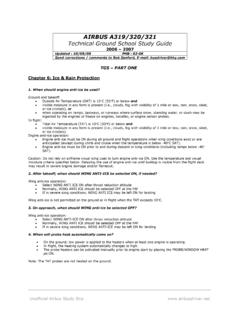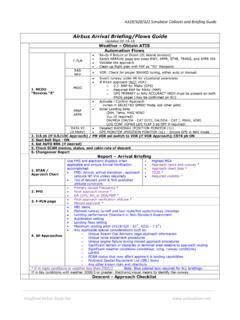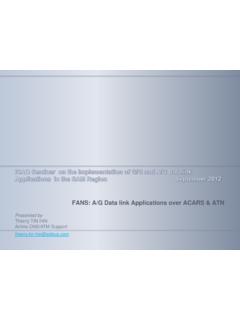Transcription of Complex failure modes in complex systems, a case study
1 Complex failure modes in Complex systems, acase study : Qantas A330 flight 72, Singapore-Perth, 7thOctober 2008 Jim Thomson, 2015 Complex systems almost always fail in Complex ways. Columbia Accident Investigation Board Report, August 2003 (c) 2015 Slide 1 QANTAS A330 upset , 7 October (c) 2015 Slide 2 Greater than -1g for just less than two secondsSee ATSB animation at of Attack (AOA) vs Pitch (c) 2015 Slide 3 The pilot cannot readily sense the Angle of Attack he relies on : ring-laser gyroscopes Modern Inertial Reference Units use ring laser gyroscopesto provide raw data. A ring laser gyroscope consists of a ring laser having two counter-propagating modes over the same path in order to detect rotation (Sagnaceffect). (c) 2015 Slide 4 Air Data Inertial Reference Units (ADIRUs) (c) 2015 Slide 5 Angle Of Attack is a critical safety parameter for the EFCS, and the Flight Control Primary Computers use three independent AOA signals to check their consistency, signals AOA1, AOA2 and AOA3.
2 The AOA signals are created by Air Data Inertial Reference Units (ADIRUs), which use ring-laser gyroscopes, Pitot tube sensors, air temperature, and GPS AOA value is then fed into the flight control system and used, in particular, to drive signals to the elevators in the tailplane which control aircraft MTBF 16000 hours. Weight are smart sensors in nuclear Grumman LTN-101 Flagship ADIRUFCPC1 Actuators forcontrol surfaces(including elevators) Normal Operations :Protection allows a predefined safe flight envelope onlyFCPC1 is Master in Normal OperationsSelf-diagnosticsInternal FCPC failure detected:FCPC2 takes over, then FCPC3 External failure detected, or outsidesafe flight envelope:(i)Alternate Law (restricted protection), or(ii)Direct Law (no protection)FCPC compares median AOA data 20 times per second.
3 FCPC 1 would normally use the average of AOA1 and AOA2, unless the difference between AOA1 and AOA2 exceeded a set value, in which case FCPC1 memorised the last valid average value for all three AOAs and used that for seconds. After seconds, the current average value would be used. Two consecutive AOA spikes in a single ADIRU, exactly seconds apart, could therefore lead to FCPC1 believing the aircraft had a high Angle of Attack, leading to FCPC1 commanding a nose-down elevator :AOA = Angle of AttackADIRU = Air Data Inertial Reference UnitFCPC = Flight Control Primary (c) 2015 Slide 6 ADIRU 1 ADIRU 2 ADIRU 3 FCPC3 FCPC2 Actuators forcontrol surfacesActuators forcontrol surfaces3 x AOA signalsKey factors from the in-flight upset of Qantas Airbus 330-303, 7thOctober 2008(adapted from Australian Transport Safety Bureau report AO-2008-70)1240:26 ADIRU 1 started providing multiple intermittent spike signals.
4 Crew received numerous warning messages (mostly spurious).1242:27 Aircraft suddenly pitched nose down, max degrees. The command lasted <2 seconds. At least 110 passengers and 9 crew injured, 12 seriously. A second less severe pitch down occurred at 1245:08. There was a limitation in the algorithm used by the A330/A340 FCPCs for processing AOA data. This limitation meant that, in a very specific situation, multiple AOA spikes from only one of the three ADIRUs could result in a nose-down elevator command. (Significant safety issue) The data-spike failure intermittent spikes on air data parameters being sent to other systems as valid data without a relevant fault message being displayed to the crew. The FCPC algorithm was very effective but it could not correctly manage a scenario where there were multiple spikes in either AOA1 or AOA2 that were seconds is very unlikely that (this) FCPC design limitation could have been associated with a more adverse occurrence fitted the classification of a hazardous effect rather than a catastrophic known case of the design limitation affecting an aircraft s flight-path in over 28 million flight was within the acceptable probability (c) 2015 Slide 7 Aircraft was in level cruise at 37000 feetKey factors from the in-flight upset of Qantas Airbus 330-303, 7thOctober 2008(adapted from Australian Transport Safety Bureau report AO-2008-70)
5 Mayday declared, flight diverted and landed successfully at 1332..the development of the A330/A340 flight control system during 1991 and 1992 had many elements to minimise the risk of design of these activities identified the design limitation in the FCPC s AOA , the design verification and validation processes used by the aircraft manufacturer did not fully consider the potential effects of frequent spikes in data from the ADIRU..the LTN-101 ADIRU's central processor unit (CPU) module combined the data value from one parameter with the label for another parameter. The failure mode was probably initiated by a single, rare type of internal or external trigger event combined with a marginal susceptibility to that type of event within a hardware component.
6 There were two other known occurrences of the ADIRU data-spike failure mode, on 12thSept 2006 and 27thDec (c) 2015 Slide 8On 15thJanuary 2009 the EASA issued Emergency Airworthiness Directive 2009-0012-E to address the Northrop-Grumman ADIRU his wife inspect a house with an estate agentSuddenly a light plane collides with the Rare Event Fallacy, as demonstrated by Robin Williams(from The World According to Garp , 1982)..causing significant damage We ll take it. It s been pre-disastered. (c) 2015 Slide 9 Findings: A single failure in one ADIRU led to an accident in a redundant system . The ADIRU fault may have been caused by a single event upset due to cosmic rays. Airbus software was improperly specified for dealing with the ADIRU conclusion: Tricky FMEAs for Complex systems using COTS smart issues of note: Flimsy retrospective PRA justification?
7 Regulatory xenophobia?Key (c) 2015 Slide 10













